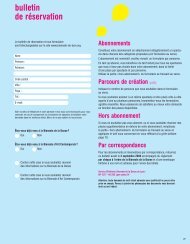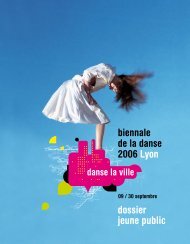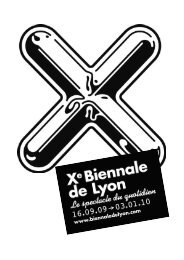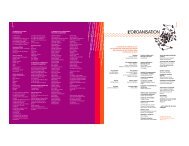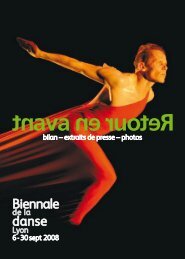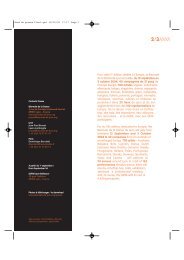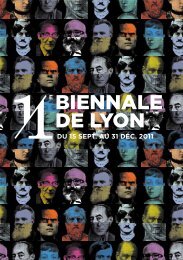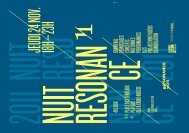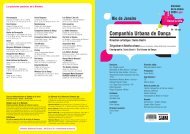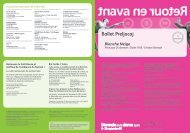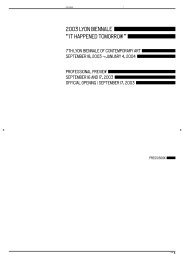Retour en Avant / Past Forward Biennale de la Danse Lyon - France
Retour en Avant / Past Forward Biennale de la Danse Lyon - France
Retour en Avant / Past Forward Biennale de la Danse Lyon - France
- No tags were found...
You also want an ePaper? Increase the reach of your titles
YUMPU automatically turns print PDFs into web optimized ePapers that Google loves.
Primo toccare / Création 2008À une époque où même <strong>la</strong> mort et le désespoir,dans notre dim<strong>en</strong>sion « médiatique »,pr<strong>en</strong>n<strong>en</strong>t <strong>de</strong>s allures cinématographiques ;à une époque où <strong>la</strong> perception artistiqueconcerne aussi les faits réels les plus viol<strong>en</strong>ts,le s<strong>en</strong>s esthétique évolue et crée <strong>de</strong> nouveauxidéaux <strong>de</strong> « beauté ».C’est pourquoi, je p<strong>en</strong>se qu’aujourd’hui <strong>la</strong>première démarche dans <strong>la</strong> création d’unballet, son ébauche, ne se situe pas parrapport à quelque chose – ou tout au moinsà quelque chose <strong>de</strong> précis dans le domaine<strong>de</strong> <strong>la</strong> danse – mais naît plutôt d’un jeu <strong>de</strong> séduction,dans le s<strong>en</strong>s d’une déviation <strong>de</strong> cequi existe déjà, du positif et du concret, uneréalité « autre ».De là naiss<strong>en</strong>t les fon<strong>de</strong>m<strong>en</strong>ts <strong>de</strong> <strong>la</strong> créationchorégraphique qui voit l’irréel comme leseul domaine possible pour <strong>la</strong> représ<strong>en</strong>tationd’un idéal <strong>de</strong> beauté.Dans une ambiance g<strong>la</strong>ciale, gazeuse etrecherchée se déploi<strong>en</strong>t <strong>de</strong>s danses quijou<strong>en</strong>t avec les s<strong>en</strong>sations que l’on éprouve<strong>en</strong> regardant et <strong>en</strong> touchant : quand on saitque si l’on touche un objet, celui-ci désormaisnous apparti<strong>en</strong>t.Tout se résout à <strong>la</strong> première touche, aupremier regard, comme à vouloir mettrel’acc<strong>en</strong>t sur <strong>la</strong> fugacité <strong>de</strong> <strong>la</strong> vie et <strong>de</strong>l’œuvre d’art elle-même. Dans un jeud’images évanesc<strong>en</strong>tes, <strong>en</strong>tre immobilitéet fluidité, se succèd<strong>en</strong>t <strong>de</strong>s <strong>en</strong>sembles, <strong>de</strong>sduos et <strong>de</strong>s trios construits sur <strong>la</strong> base dumatériau <strong>de</strong> <strong>la</strong> technique dite c<strong>la</strong>ssique,mais avançant dans un champ d’action trèscontemporain, qui finit par produire, plutôtqu’une soirée <strong>de</strong> danse, une expéri<strong>en</strong>ce <strong>de</strong>danses. Le duo d’artistes visuels corpicrudi(Samantha Stel<strong>la</strong> et Sergio Frazzingaro)procè<strong>de</strong> aussi <strong>de</strong> cette ori<strong>en</strong>tation esthétiquepour réaliser <strong>de</strong>s projets hybri<strong>de</strong>s<strong>en</strong>tre art contemporain, musique et mo<strong>de</strong> ;ils abord<strong>en</strong>t ici l’espace scénique où ilstraduis<strong>en</strong>t architecturalem<strong>en</strong>t l’élégance<strong>de</strong> <strong>la</strong> composition et <strong>la</strong> recherche formelle.La danse et le décor se déploi<strong>en</strong>t toutefoissur <strong>de</strong>ux binaires distincts, se r<strong>en</strong>contrant,à <strong>la</strong> limite, par l’effet du hasard, commele conçoit Merce Cunningham. Ces danses,transpar<strong>en</strong>tes comme le verre et <strong>la</strong> lumièreb<strong>la</strong>nche, veul<strong>en</strong>t incarner <strong>la</strong> fugacité <strong>de</strong>l’œuvre d’art elle-même.Matteo LevaggiComm<strong>en</strong>t le passé peut-il <strong>de</strong>ssiner le futur ?J’ai toujours p<strong>en</strong>sé qu’un travail artistique libre etcréatif ne peut pas se limiter à une recherche acharnée<strong>de</strong> trouvailles théâtrales «nouvelles» qui vis<strong>en</strong>t àétonner le spectateur. Il faut rester <strong>en</strong> équilibre sur ceque l’histoire nous a <strong>la</strong>issé, et <strong>de</strong> là, avancer librem<strong>en</strong>t.Je songe à Ba<strong>la</strong>nchine et à Cunningham et à leurregard audacieux mais sans préjugés vers le passé ; àmon tour, je ress<strong>en</strong>s <strong>la</strong> nécessité <strong>de</strong> monter sur leursépaules pour chercher à regar<strong>de</strong>r plus loin.Matteo LevaggiInfo +Première mondialeCoproduction Bi<strong>en</strong>nalewww.ballettoteatroditorino.itBalletto Teatro di TorinoThe company was foun<strong>de</strong>d in Turin in the 1970sand hea<strong>de</strong>d by Loredana Furno, principal dancerwith the Teatro Regio, with the aim of offeringan alternative to the dance shows of theperiod and an artistic approach that embracedother performance disciplines. In its early yearsthe company staged new works, oft<strong>en</strong> set tooriginal music, by important figures of the timesuch as Vittorio Biagi, Roberto Fascil<strong>la</strong>, LorisGai and Milorad Miskovitch. Th<strong>en</strong> in the ’80sand ’90s, continuing its search for new i<strong>de</strong>as, itincreasingly op<strong>en</strong>ed up to contemporary dance,performing work by choreographers includingJob San<strong>de</strong>rs, Roberto Castello, Bertrand d’At,Charles Vodoz and Jozsef Tari. The José LimónDance Foundation in New York ev<strong>en</strong> <strong>en</strong>trustedit with There Is a Time, one of the Americanchoreographer’s masterpieces.Its research and historical memory <strong>de</strong>partm<strong>en</strong>thas <strong>en</strong>abled the realisation of major monographicprojects on José Limón (1995), SergeLifar (1997), Aurel Milloss (1999) and KaroleArmitage (2000); each show was linked withexhibitions, colloquia and masterc<strong>la</strong>sses. But thecompany’s main focus remains contemporarydance: it has premièred works by Luca Veggetti,Loris Petrillo, Gigi Caciuleanu and Karole Armitage.In 2001, Balletto Teatro di Torino re<strong>de</strong>finedits artistic profile with the appointm<strong>en</strong>t of MatteoLevaggi as resid<strong>en</strong>t dancer/choreographer;un<strong>de</strong>r his lea<strong>de</strong>rship, the company has r<strong>en</strong>ewedits image. Over the years, the company hasstaged some 60 productions and performed allover the world.Matteo LevaggiHe trained at the Balletto Teatro di Torino schoolun<strong>de</strong>r Loredana Furno. From 1993-96 he cameto notice in various competitions including theConcours International <strong>de</strong> <strong>Danse</strong> in Paris. Afterjoining the company, he distinguished himselfas a soloist, through its artistic personality andthrough the exceptional quality of his movem<strong>en</strong>t.Several choreographers have since chos<strong>en</strong>him to perform their work. In 1997-98 he wasa member of Aterballetto, the company led bychoreographer Mauro Bigonzetti; and th<strong>en</strong> w<strong>en</strong>tfree<strong>la</strong>nce, dancing in several productions such asLes Mémoires d’Hadri<strong>en</strong>, alongsi<strong>de</strong> Italian actorGiorgio Albertazzi.In 2000 he featured in an important new workby American choreographer Karole Armitage:Io Giacomo Casanova, pres<strong>en</strong>ted at the Ath<strong>en</strong>sFestival. In the same year, he was invited tothe Cuba International Ballet Festival run byAlicia Alonso. After the success of his first pieceSalomè (1999), for Balletto Teatro di Torino,Loredana Furno appointed him as the company’sresid<strong>en</strong>t choreographer. With the creative andpersonal directions he has since tak<strong>en</strong>, focusedon creating choreography and on his everydaywork with the dancers, Levaggi has nurtured an“auteur company”. It is increasingly making itsmark as one of Italy’s leading companies.In just a few years, he has created several piecesfor his company: Gee, Andy! (2001), Slippery-Friction-Skipped and stretch (2003), Ray Man(2004), Jeu d’écarts (2005), Differ<strong>en</strong>tia (2005),Off Again (2006) and Surrogate Cites (2007);but also Caravaggio (2004) for the Teatro CarloFelice in G<strong>en</strong>oa, Drowning by Numbers (2005)and La Boutique fantasque (2006) for the BallettoDell’Ar<strong>en</strong>a in Verona. At the 2006 V<strong>en</strong>iceDance Bi<strong>en</strong>nale (director: Ismael Ivo) he premièredCanto bianco in un mom<strong>en</strong>to di orizzonteverticale. In 2007 the Zagreb Music Bi<strong>en</strong>nale(Croatia) commissioned from Levaggi a piece setto music by Heiner Goebbels, a major contemporarycomposer, with whom the Italian hadalready col<strong>la</strong>borated on a “Goebbels Project”with the BTT as part of a season at the TeatroStabile in Turin. Much of Matteo Levaggi’s successhas come with the Balletto Teatro di Torino,and Italian critics now consi<strong>de</strong>r him an origina<strong>la</strong>nd inv<strong>en</strong>tive choreographer. His dynamic andintoxicating dance, with its <strong>de</strong>liberate “formality”,has captured the public’s <strong>en</strong>thusiasm.Primo toccare / 2008 creationIn an age wh<strong>en</strong>, in our “media dim<strong>en</strong>sion”,ev<strong>en</strong> <strong>de</strong>ath and <strong>de</strong>spair acquire the look of cinematography;and in an age wh<strong>en</strong> artistic perceptionalso covers the most viol<strong>en</strong>t of actual facts,the aesthetic s<strong>en</strong>se is evolving and creating newi<strong>de</strong>als of “beauty”. This is why I now think thatthe first step in creating a ballet – the roughsketching – does not re<strong>la</strong>te to anything, or atleast not to any precise thing, in the domain ofdance; rather, it stems from a game of seduction,in the s<strong>en</strong>se of being a diversion from whatalready exists, from the positive and concrete;some “other” reality. This yields the foundationsof choreographic creation, which sees unrealityas the only possible realm in which to portray ani<strong>de</strong>al of beauty. In an icy, gaseous and studiedatmosphere, dances unfold that p<strong>la</strong>y with thes<strong>en</strong>sations we feel wh<strong>en</strong> we watch and touch;wh<strong>en</strong> we know that if we touch an object, th<strong>en</strong>it belongs to us. Everything hinges on the firsttouch, the first g<strong>la</strong>nce; on the wish to emphasisethe fleetingness of life and of the work of artitself. In a p<strong>la</strong>y of evanesc<strong>en</strong>t images, hoveringbetwe<strong>en</strong> stillness and fluidity, a sequ<strong>en</strong>ce of <strong>en</strong>sembles,duos and trios is performed, based onthe material of the so-called c<strong>la</strong>ssical techniquebut in a highly contemporary field of action; thisultimately produces an experi<strong>en</strong>ce of dancesrather than an ev<strong>en</strong>ing of dance. Corpicrudi, aduo of visual artists (Samantha Stel<strong>la</strong> and SergioFrazzingaro), also take this aesthetic stance inor<strong>de</strong>r to execute projects bl<strong>en</strong>ding contemporaryart, music and fashion; here they addressthe sc<strong>en</strong>ic space, r<strong>en</strong><strong>de</strong>ring architecturally theelegance of the composition and its explorationof form. However, dance and <strong>de</strong>cor fit twodistinct binary systems; they might almost besaid to meet by chance, as in Merce Cunningham’sconception. These dances, as transpar<strong>en</strong>tas g<strong>la</strong>ss and white light, seek to embody thefleetingness of the work itself.How can the past shape the future?I have always felt that free, creative, artistic activitycannot just be a rel<strong>en</strong>tless search for “new“ theatricalelem<strong>en</strong>ts int<strong>en</strong><strong>de</strong>d to amaze the spectator. There mustbe a ba<strong>la</strong>nce betwe<strong>en</strong> what history has han<strong>de</strong>d us andour own free progress. I think of Ba<strong>la</strong>nchine and Cunningham,who looked at the past boldly and withoutprejudice; now, in turn, I feel the need to “climb ontheir shoul<strong>de</strong>rs“, trying to look further ahead.Matteo LevaggiExtra info:World premiereCo-produced by the Bi<strong>en</strong>nalewww.ballettoteatroditorino.it41



